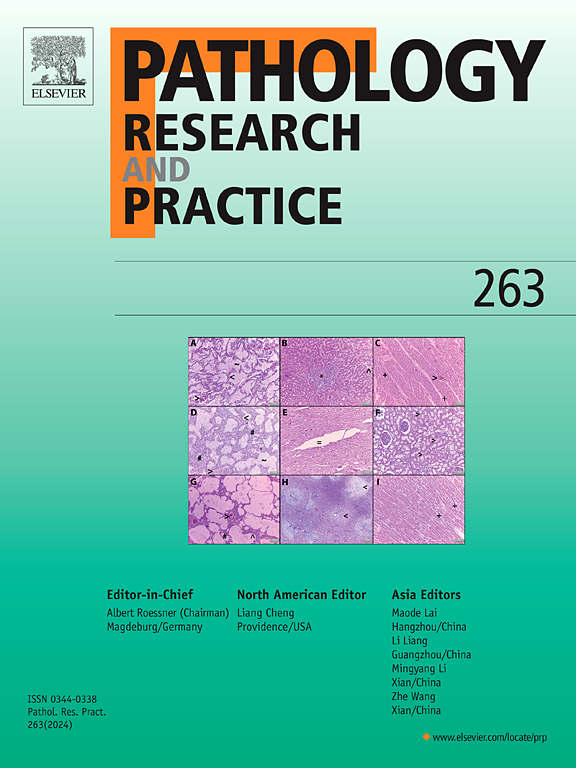心肌梗死中乳酸代谢相关诊断标志物的鉴定与分析
IF 2.9
4区 医学
Q2 PATHOLOGY
引用次数: 0
摘要
乳酸代谢与心肌梗死(MI)有关,但其潜在机制尚不完全清楚。鉴定乳酸代谢相关基因(LMRGs)可以发现新的心肌梗死诊断和治疗靶点。我们对GeneCards数据库进行了生物信息学分析,鉴定出498个LMRGs,并将它们与心肌梗死样本中的差异表达基因(DEGs)交叉,得到17个关键基因。我们利用共识聚类和加权基因共表达网络分析(WGCNA)将基因列表细化到981个候选基因。机器学习算法确定了三种生物标志物:OLIG1、LIN52和RLBP1,它们与“核糖体”和“碳代谢”途径相关。进行富集分析和免疫微环境评估,构建药物-基因相互作用和激酶转录因子(TF)-mRNA-miRNA网络,探索这些基因的功能和潜在的治疗意义。这三种生物标志物与免疫细胞类型有显著相关性,其中OLIG1与单核细胞的正相关性最高,与中性粒细胞的负相关性最高。药物基因网络揭示了潜在的相互作用,如甲基吡啶与LIN52和“双酚A”与RLBP1。激酶- tf - mrna - mirna网络由209个节点和470个边组成,表明其调控机制复杂。我们的研究确定了与心肌梗死相关的乳酸代谢的三个关键生物标志物,OLIG1, LIN52和RLBP1,为潜在的诊断标志物和治疗靶点提供了见解。这些发现为进一步研究这些生物标志物在心肌梗死中的分子机制提供了依据。本文章由计算机程序翻译,如有差异,请以英文原文为准。
Identification and analysis of diagnostic markers related to lactate metabolism in myocardial infarction
Lactate metabolism is implicated in myocardial infarction (MI), yet the underlying mechanisms are not fully understood. Identifying lactate metabolism-related genes (LMRGs) could uncover new diagnostic and therapeutic targets for MI. We conducted a bioinformatics analysis on GeneCards database to identify 498 LMRGs and intersected them with differentially expressed genes (DEGs) from MI samples, yielding 17 key genes. We utilized consensus clustering and weighted gene co-expression network analysis (WGCNA) to refine our gene list to 981 candidate genes. Machine learning algorithms identified three biomarkers: OLIG1, LIN52, and RLBP1, associated with 'ribosome' and 'carbon metabolism' pathways. Enrichment analyses and immune microenvironment assessments were performed, and networks including drug-gene interactions and kinase-transcription factor (TF)-mRNA-miRNA were constructed to explore the functions and potential therapeutic implications of these genes. The three biomarkers showed significant correlations with immune cell types, with OLIG1 having the highest positive correlation with monocytes and the highest negative correlation with neutrophils. The drug-gene network revealed potential interactions such as methapyrilene with LIN52 and 'bisphenol A′ with RLBP1. The kinase-TF-mRNA-miRNA network comprised 209 nodes and 470 edges, indicating complex regulatory mechanisms. Our study identified three key biomarkers, OLIG1, LIN52, and RLBP1, in lactate metabolism associated with MI, providing insights into potential diagnostic markers and therapeutic targets. These findings warrant further investigation into the molecular mechanisms of these biomarkers in MI.
求助全文
通过发布文献求助,成功后即可免费获取论文全文。
去求助
来源期刊
CiteScore
5.00
自引率
3.60%
发文量
405
审稿时长
24 days
期刊介绍:
Pathology, Research and Practice provides accessible coverage of the most recent developments across the entire field of pathology: Reviews focus on recent progress in pathology, while Comments look at interesting current problems and at hypotheses for future developments in pathology. Original Papers present novel findings on all aspects of general, anatomic and molecular pathology. Rapid Communications inform readers on preliminary findings that may be relevant for further studies and need to be communicated quickly. Teaching Cases look at new aspects or special diagnostic problems of diseases and at case reports relevant for the pathologist''s practice.

 求助内容:
求助内容: 应助结果提醒方式:
应助结果提醒方式:


